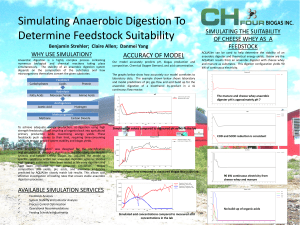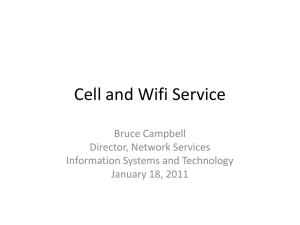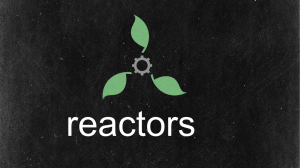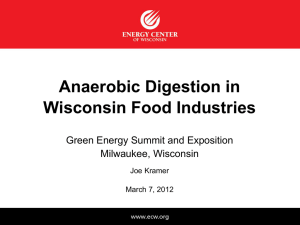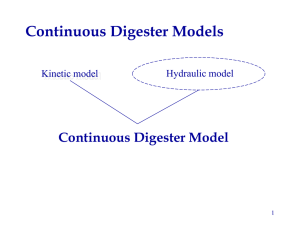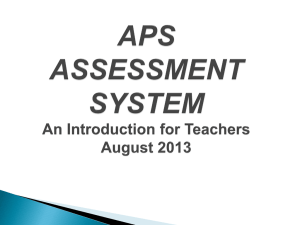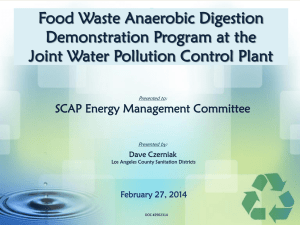Food Waste
advertisement
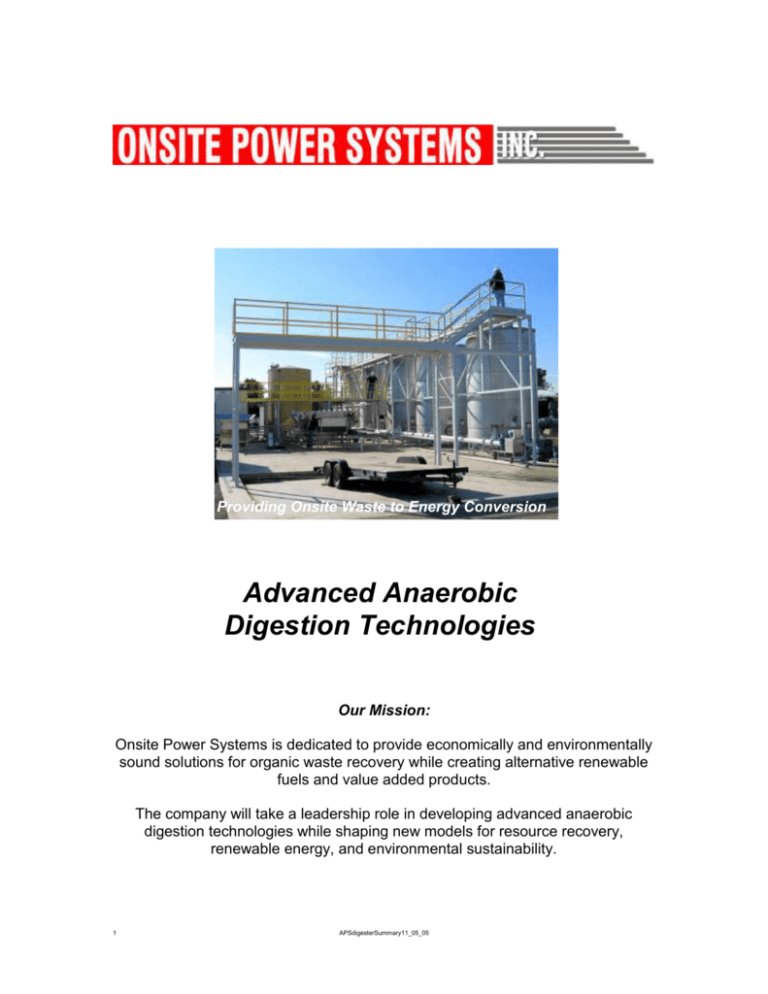
Providing Onsite Waste to Energy Conversion Advanced Anaerobic Digestion Technologies Our Mission: Onsite Power Systems is dedicated to provide economically and environmentally sound solutions for organic waste recovery while creating alternative renewable fuels and value added products. The company will take a leadership role in developing advanced anaerobic digestion technologies while shaping new models for resource recovery, renewable energy, and environmental sustainability. 1 APSdigesterSummary11_05_05 Advanced Anaerobic Phased Solids (APS) Digestion Technology Onsite Power Systems, Inc. (OPS) is a privately held company, which has acquired the exclusive licensing agreement to an advanced anaerobic digester process, patented by the University of California Regents (UC Regents), patent # 6,342,378. This Anaerobic Phased Solids (APS) digester process incorporates a new, high-rate bioconversion technology developed by Dr. Ruihong Zhang in the Biological and Agricultural Engineering Department at the University of California, Davis (UC Davis). Dr. Zhang’s process exhibits significant advantages over existing, anaerobic digestion technologies. These advantages stem from several innovative design features that allow optimum environmental conditions for the system’s microorganisms, resulting in significantly shorter retention time with an expedient and efficient conversion of organic feedstock into biogas and beneficial valueadded byproducts. Anaerobic Digestion is not new; it has existed about as long as life has been present on earth. Anaerobic digestion, a naturally occurring process, is the bacterial breakdown of organic materials and by definition, is an anaerobic process meaning that it proceeds in the absence of oxygen. Anaerobic digestion is currently a worldwide-accepted technological process incorporated in the digestion systems of sewage and municipal wastewater plants with thousands of these systems currently in operation. Compared with existing anaerobic digester systems, the APS digester is: o o o o Capable of handling non-homogeneous solids Requires less material handling equipment Exhibits lower operational energy consumption Requires smaller digester tanks resulting in reduced capital investments The APS process compared with the most recently proposed digester for solid waste conversion, sequential batch anaerobic composting (SEBAC) reactors (Chenowyth, 1991), has demonstrated superior performance in terms of its ability to process more solids per unit digester volume, producing a higher methane content biogas at a more constant rate (Zhang & Zhang, 1998). Additionally, as reported in the above referenced literature, the conventional plug-flow digesters and completely mixed digesters used in the past for digestion of solid wastes were found to be energy intensive in operation and exhibited problematic material handling characteristics. 2 APSdigesterSummary11_05_05 The APS can process waste streams with a high percentage of solids, typically 30% in comparison with other anaerobic digesters that typically handle up to 5% solids such as in wastewater treatment digesters. This allows the APS system to digest a wide variety of biomass materials including food processing waste, agricultural crop residues, animal waste streams, and municipal green waste. . Depending upon the type of biomass material, the APS can convert 60 to 90% of the organic solids to biogas. Any remaining solids have a value as a soil amendment or fertilizer additives. The APS process offers significant advantages over existing, anaerobic digestion technologies. These advantages stem from several innovative design features that allow optimum environmental conditions for the system’s microorganisms, resulting in significantly shorter retention time with an expedient and efficient conversion of organic feedstock into biogas and beneficial valueadded byproducts Potential Market for APS Digester Systems in California Information on available organic waste presented in a recent draft report from the California Biomass Collaborative (2003) and information provided by California Integrated Waste Management Board reveals an estimated 6.7 million dry tons (approximately 22 million wet tons) per year of organic wastes are produced in California. This volume of organic wastes can daily produce enough biogas fuel supply to generate approximately: o 895,000 Kg of biohydrogen per day or o 1,363,000 gallons of gasoline equivalent bio-CNG per day or o 9,680 megawatt-hrs of renewable electricity per day, 365 days a year. Multiple APS Digesters will reduce State’s reliance on imported oil. Placed in strategic locations throughout the state of California, APS digesters, codigesting municipal food and green wastes mixed with animal and other agricultural wastes, can provide multiple distributed energy generation sites decreasing California’s vulnerability to grid failure, while providing environmental, and economic benefits to the State. 3 APSdigesterSummary11_05_05 APS Systems Providing: Biohydrogen - Biomethane - Biofuels Biohydrogen and biomethane are two types of gaseous biofuels that the APS digester produces from organic wastes; in particular from food processing waste, pre and post consumer food waste and cheese whey permeate. The biogas produced is a medium quality fuel ranging in energy value from 580 to 650 Btu per standard cubic foot, which is approximately 60% of the energy value of pipeline natural gas. During the conversion of waste to biogas, approximately 20 to 25 % of the energy produced can be in the form of biohydrogen, with the remaining energy in the form of biomethane. This separate co-production of biohydrogen and biomethane yields biofuels for specific uses and by blending the two gases; the formation of one efficient burning biofuel (Hythane) is attained When the demand for biohydrogen and Hythane is low, the two biofuels may be mixed to produce a clean burning biofuel to operate CNG vehicles or fuel a fuel cell or an internal combustion engine for electrical generation. Additional processing will yield pipeline quality natural gas. Biohydrogen, a Benefit to California’s Hydrogen Economy Presently, commercial hydrogen primarily extracts from petrochemical resources, releasing sequestered carbon dioxide (CO2), a green house gas, in the process. Hydrogen extracted from organic material (biohydrogen) is truly a renewable resource, developed without releasing sequestered carbon dioxide during its extraction process. Clean combustion of hydrogen & biohydrogen yield highenergy (142 kJ/g) without producing carbon dioxide. During the early stages of development of the California’s “Hydrogen Highway” infrastructure, the demand for pure biohydrogen as a vehicle fuel will be lower than the demand for other automotive fuels such as compressed natural gas (methane gas). However, the number of automobiles requiring biohydrogen fuel will increase with time and the APS digester’s flexibility to produce biohydrogen, methane and/or Hytane demonstrates it can be a principle factor in the early establishment of the “Hydrogen Highway”. 4 APSdigesterSummary11_05_05 Biohydrogen – Biofuels Development Project The Biohydrogen and biofuels development project is designed to demonstrate the ability to develop the hydrogen economy and the California Hydrogen Highway program based on utilizing renewable fuel sources. The focus of this project is to: o Advance the current research o Develop design and operational parameters o Demonstrate a commercial system for stable, predictable and practical production of biohydrogen, methane and other biofuels o Demonstrate how these systems will play a critical role in the development of the renewable hydrogen economy. The project will involve design modifications to the existing APS digester demonstration system located at UC Davis. The design will allow for the processing of various organic waste materials for the production of biohydrogen. Additionally, the biohydrogen will be either blended for Hythane production, or will be fully converted to methane to operate a fuel cell or internal combustion engine. Formation of the Biohydrogen – Biofuels Project Team The establishment of a unique teaming arrangement allows the development of an APS Digester Biohydrogen – Biofuels project at the UCD campus. The Team o OPS is providing the design, construction, and functional configuration of the APS digester system. o Air Products, Inc. is sponsoring the biohydrogen production, laboratory studies and will be providing the biohydrogen and biofuels system design including the production equipment. o UC Davis is providing the biological engineering, set the operational parameters, and perform operational system monitoring. o Eco Soul is providing the public outreach and educational programs in sustainable practices, resource recovery and renewable energy. The biohydrogen project collaborative team brings with it a strong, multidisciplinary team of experts with interrelated capabilities and resources to insure the successful development of this project. 5 APSdigesterSummary11_05_05 APS Digester Development & Commercialization First phase pilot digester development was started in 1999 when OPS constructed a (1,800-gallon total reactor volume) pilot APS digester plant at the old wastewater treatment plant on the UC Davis campus and successfully demonstrated the scalability of the system from the 4-liter laboratory reactors. System design testing of: • • • • Material handling Circulation system System components Computer controls System analysis of: • • • • Gas production Material processing Process controls Hydraulic mixing Second phase pilot digester development started in 2000 when OPS dismantled the 1,800-gallon Pilot plant and constructed a larger 14,000-gallon total reactor volume pilot APS digester plant at the site of the new UC Davis wastewater plant. The primary function of the second phase pilot system was the evaluation of a variety of commercially available equipment and components. Engineering evaluation of commercially available: • • • • 6 APSdigesterSummary11_05_05 Material handling systems Material processing equipment Circulation system • Pumps • Valves • Controls Drain system valves, pumps and piping Small Scale APS Digester Commercial Demonstration System The California Energy Commission issued a grant to Dr. Zhang and UC Davis in July 2004 for the amount of $995,000 (contract #500-02-004) to demonstrate, validate performance and commercialize the APS anaerobic digester technology. OPS grant participation involves a construction contract and research agreement with UC Davis (K010611-01). The contract directed OPS to construct a 50,000-gallon total reactor volume, commercial demonstration digester system to be located on the UC Davis campus at the current OPS pilot digester site. The designs and techniques incorporated in the commercial APS digester system presently under construction at UC Davis follows commercially proven, industry standards. There are no dependencies upon unproven technological developments to successfully achieve the anticipated system operation. The complete system will be constructed using commercially available components. Demonstration system design allowances have been incorporated for future demonstration of various other technologies that will enhance the APS system. Some of the planned technologies include a reformer for biohydrogen production, compressed natural gas system (CNG) and a non-combusting fuel cell power generator. Additionally, a small liquefier for the production of liquid hydrogen (LH2) and/or liquefied natural gas (LNG) may be added to the system. The OPS research agreement specifies that OPS will have the first rights to all intellectual property developed during the execution of the agreement. Currently OPS and Dr. Zhang, the primary research scientist, have filed one patent disclosure and have a second potential patent disclosure in process. 7 APSdigesterSummary11_05_05 The OPS Opportunity The UC Regents/UC Davis patented technology offers OPS the opportunity to position itself as a leader in providing efficient anaerobic digester technologies in the rapidly developing national bio-industry. One of the primary driving forces of this new bio-industry is recovering organic biomass waste as a source of renewable, sustainable energy. The economic and technical viability of large-scale commercial APS digester systems, validated with the completion and operation of the system at UC Davis, allows OPS to actively market the APS digester technology and establish commercial projects. Current waste disposal regulations provide OPS an excellent opportunity for the commercialization of the APS digester technology. Based upon planned projects and forecasted sales projections, OPS is in a strong position to capture a sizeable portion of a new and profitable biomass market, positioning itself as a leader in this rapidly developing, industry. Through strategic business developments, OPS will take a leadership role in shaping new models for resource recovery, renewable energy, and environmental sustainability. APS Digester Systems Providing Sustainable Solutions Tomorrow’s world will heavily rely upon renewable resources, advanced food production systems, and new industrial technologies that will bring about fundamental changes in waste management and resource recovery. Anaerobic digestion is currently accepted globally as a necessary and viable technological process. OPS’s APS digester system advances this process to a new level, offering immediate and viable solutions to customer’s problems while creating lucrative business opportunities to its investors. For information regarding project development, business development and investment opportunities, contact: David Konwinski Onsite Power Systems, Inc. Website - www.onsitepowersystems.com Email - onsitepower@comcast.net (559) 271-2970 8 APSdigesterSummary11_05_05


